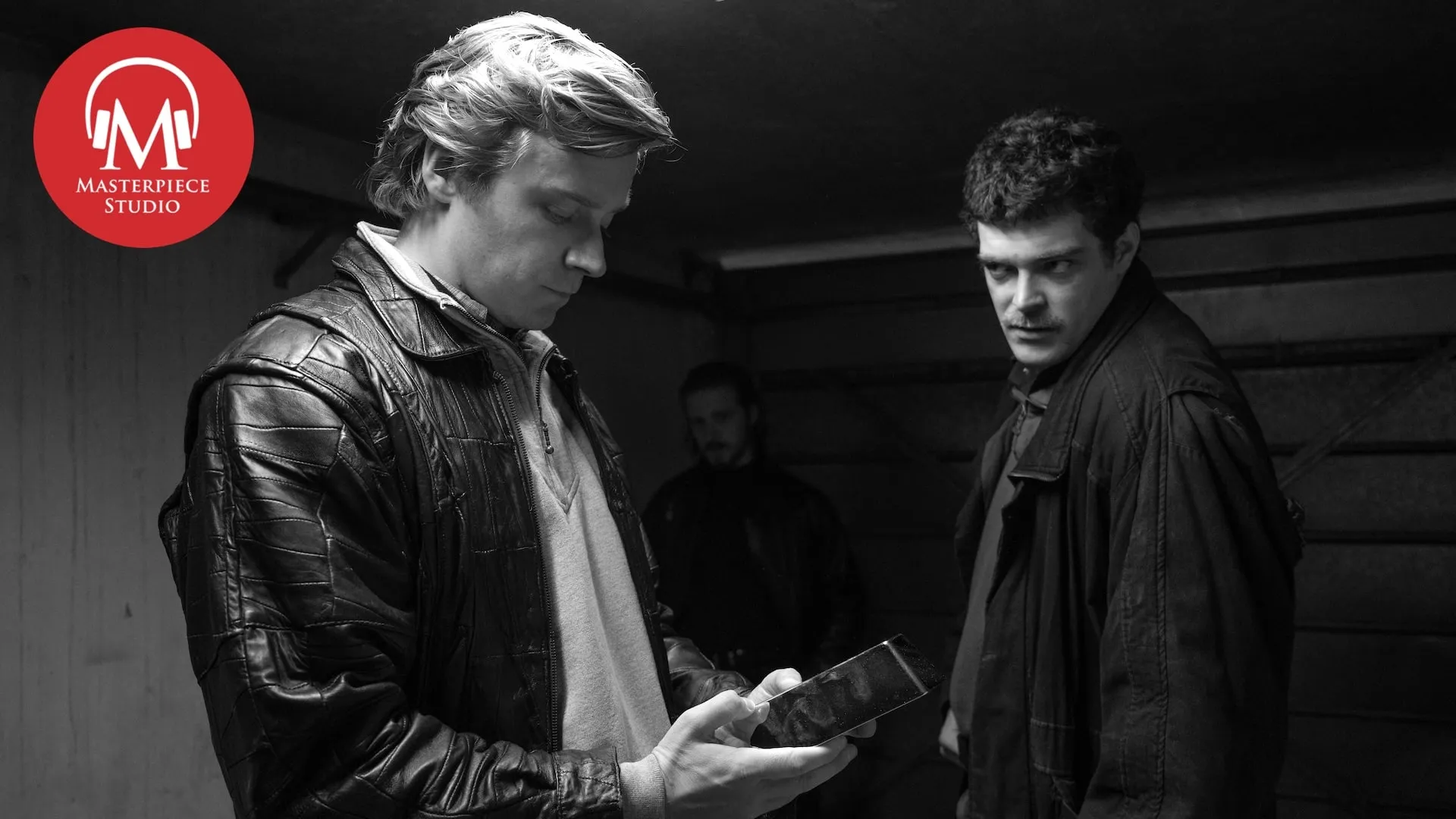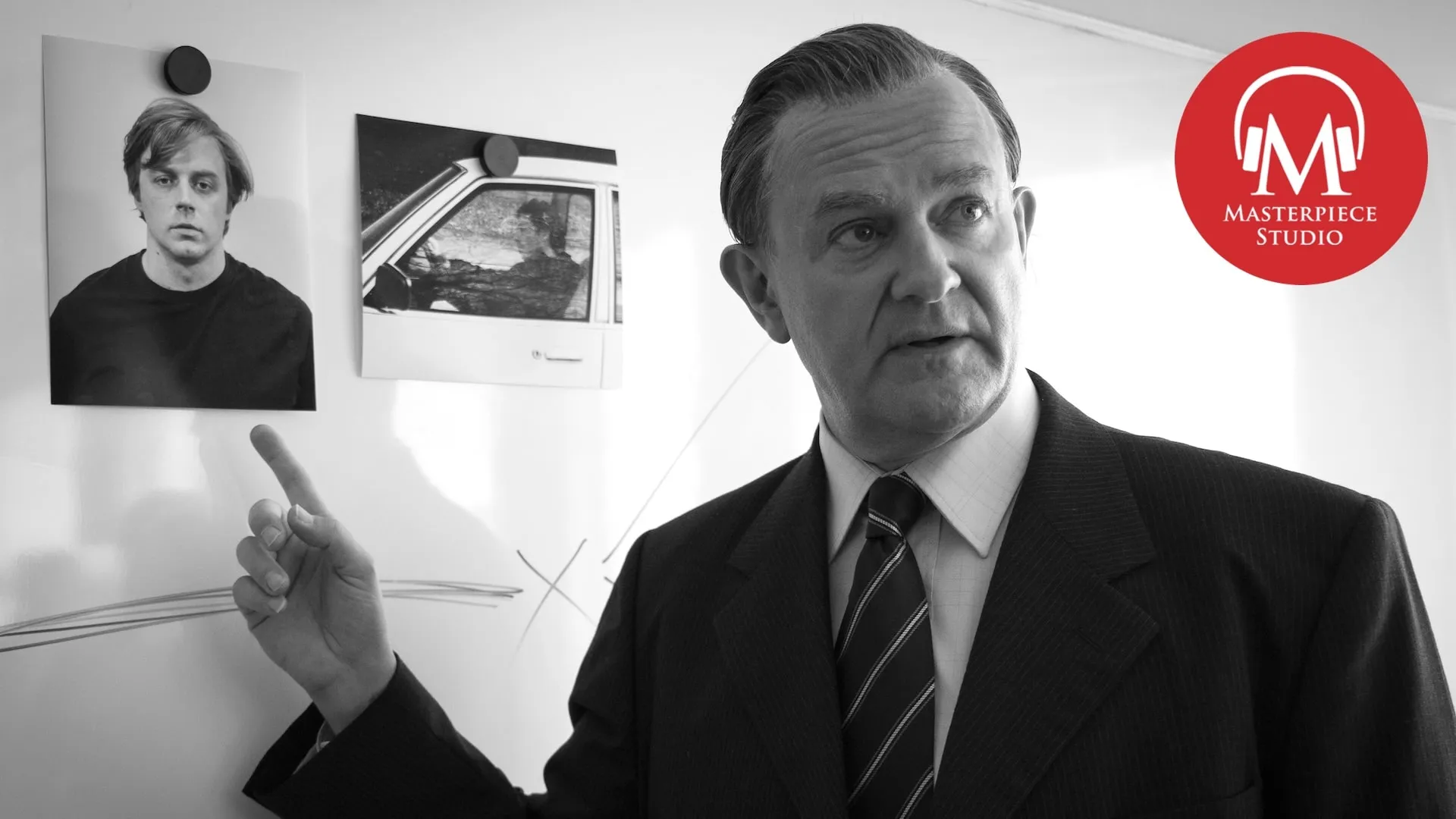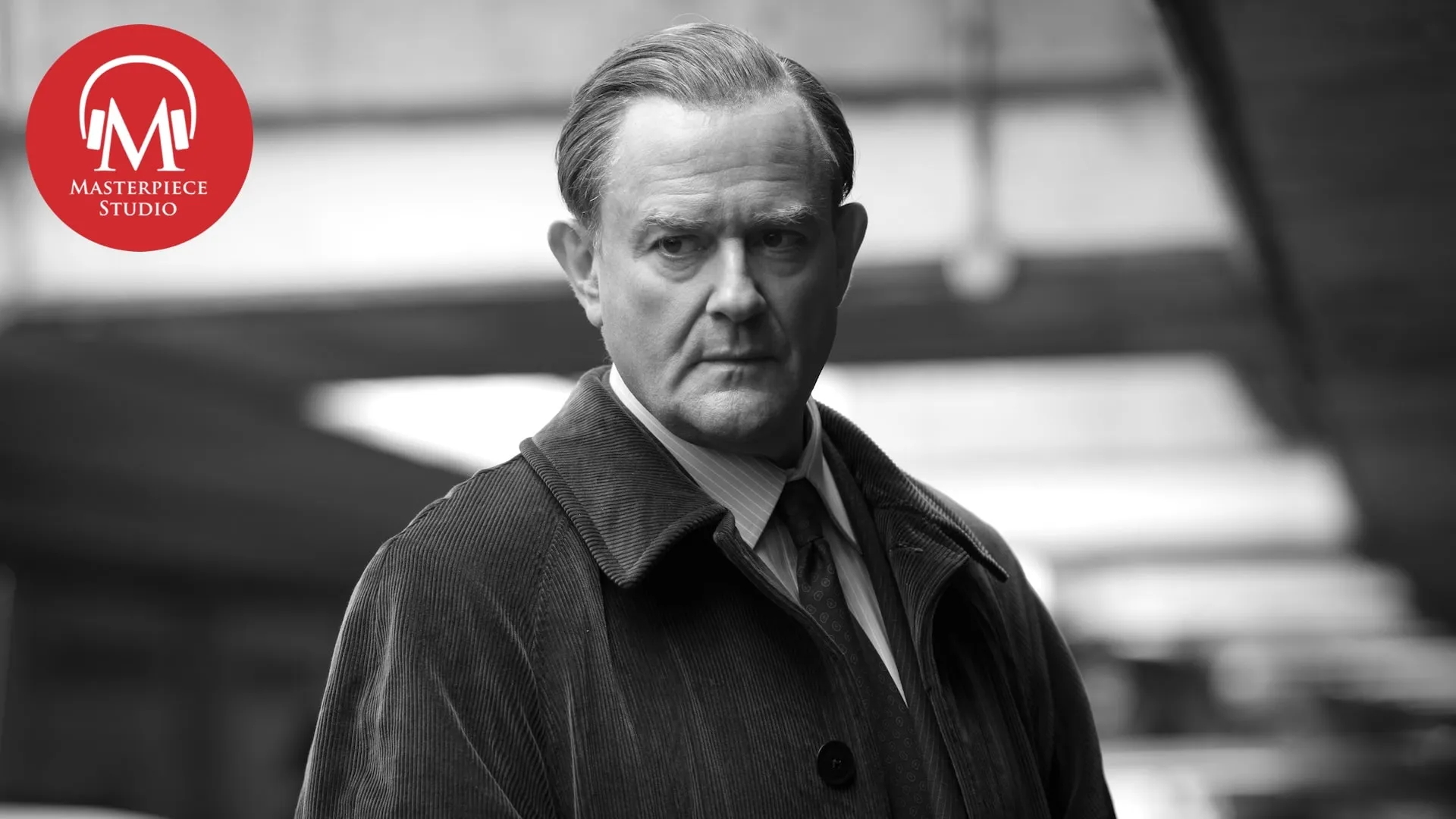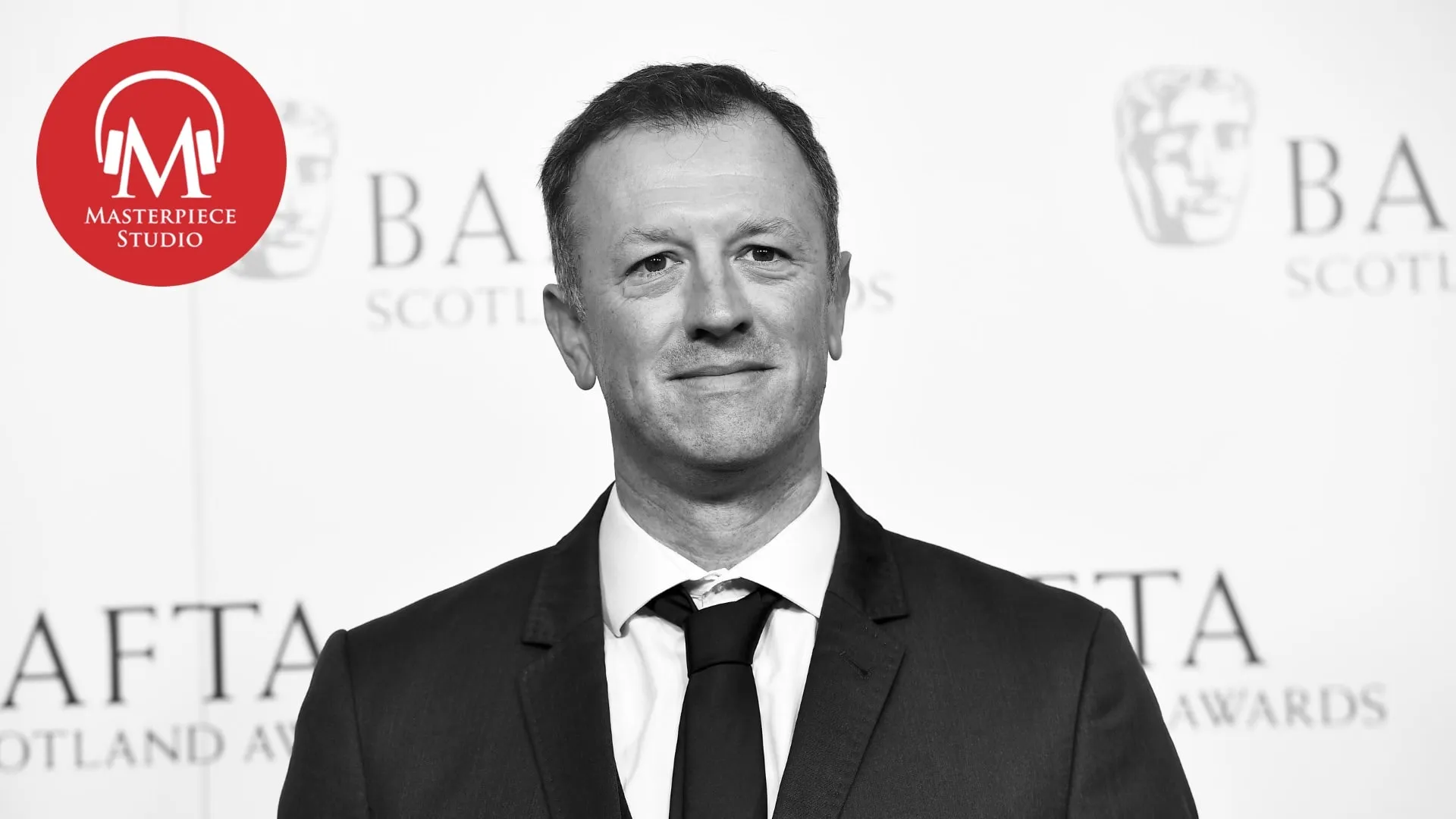
Elements of the Heist, The Gold, Season 1 | MASTERPIECE Studio
Released October 10, 2025 20:14
The Gold writer and creator Neil Forsyth returns to the podcast in this special episode for an in-depth discussion on details of the larger-than-life heist. He explains the massive social transformation in 1980s Britain, why three tons of gold was at the Brink’s-Mat warehouse, the rumors of police corruption, and more. After this conversation, we guarantee you’ll be able to appreciate every “truth is stranger than fiction” nuance of The Gold.
This script has been lightly edited for clarity.
Jace Lacob: I’m Jace Lacob and you’re listening to MASTERPIECE Studio.
The 26th of November, 1983. 6:40 a.m. The guards at the Brink's-Mat warehouse at Heathrow Airport are just settling into their shift and having their morning tea when six armed men, masked in yellow-green balaclavas, force their way into the secure facility. Making their way to the vault, the robbers expect to find roughly £1 million worth of foreign currency, but instead find something even shinier — £26 million worth of solid gold bullion.
CLIP
DI Jennings: If your mate hadn’t had his little meltdown, they’d have gotten in the vault.
Freddie: Well, not getting in the vault was the best thing that ever happened to them.
DI Jennings: How’s that, then?
Freddie: The gold wasn't in the vault because it was too much for the vault.
DI Brightwell: What do you mean "too much"?
Freddie: I've worked here a long time, and I've never seen a load like it. And I'll tell you something else, they didn't know it was here. Now, I can't decide if that's a lot of luck or no luck at all.
The Brink’s-Mat robbery has gone down as one of the largest heists in British history, transforming the Metropolitan police force, the landscape of Britain’s capital city, and international banking policies. What follows in the wake of the theft at the Brink’s-Mat storage facility is a classic case of truth being far stranger than fiction. Police corruption, Freemasons, money laundering, high-stakes stake-outs, explosive courtroom scenes, and brilliantly ruthless villains, this story truly has it all… and then some.
CLIP
Kenneth Noye: That's three ton of pure gold that you've taken out of the market and brought to a lockup in South London. And now you need to take it out of a lockup in South London and get it back into the market without anyone noticing. There's two people in England who know how to do that, and neither of us live in Basildon. I'll be in touch.
By now, you’ve hopefully watched the first episode of The Gold and have been introduced to the robbery itself, the criminal masterminds behind the operation, and Jennings, Brightwell, and Boyce — the key figures chasing down these criminals and the gold. Now, this is a dense story with a lot of moving parts, and chances are you have some questions. But fret not, we’ve got you covered.
In this episode, we speak with The Gold writer and creator Neil Forsyth. Neil will bring us up to speed on the massive social transformation that was going on in Britain in the 1980s, why three tons of gold was at the Brink’s-Mat warehouse, why the Metropolitan Police was rife with rumors of corruption, and more. After this conversation, we guarantee you’ll understand and appreciate every nuance of The Gold.
Jace Lacob: This week we are joined by The Gold writer and executive producer, Neil Forsyth. Welcome.
Neil Forsyth: Thanks for having me.
Jace Lacob: Let's start at the beginning. In 2025, most of us operate within a cashless society, but that was not the case in 1983, the year of the Brink's-Mat heist. Why was three tons of gold being held in the Brink's-Mat warehouse at unit 7 at Heathrow Airport?
Neil Forsyth: Well, it was due to fly the next day. The Heathrow warehouse held a lot of goods that were obviously then sent in freight from the airport. So it was going to be sent the following day. That was the plan.
Jace Lacob: Britain in the early 1980s is in the midst of massive transformation, as a new order takes place under the Tory government and a new class of yuppies defined by greed and materialism. “What was true for society was true for crime”, you write. How does the Brink's-Mat heist encapsulate that tension between the old and the new?
Neil Forsyth: Well, first of all, institution is in flux. I mean, that's a big thing in 1983 Britain, and it's certainly a big thing in our show. We show institutions creaking, really, with new realities. And that includes the Metropolitan Police, who had slightly outdated expertise, I suppose. And they found themselves a little bit adrift with some of the new forms of crime that were coming in.
But equally, we show banking institutions who worked on trust. We showed how they were being manipulated through a new form of money laundering. And we kind of took that thematic approach to criminality in that I think The Gold, the Brink's-Mat heist was really the last hurrah for traditional British crime. It was both the apex for British traditional crime in terms of the heist itself, but it was also the end. So, what British society saw were institutionalised certainties suddenly become very uncertain.
Jace Lacob: Along the lines of those institutions, the Metropolitan Police Force at the time is rife with rumours of corruption. Why was the British police force so vulnerable to corruption at the time?
Neil Forsyth: I think it's probably a little bit harsh to say it was the British police force. It's police against criminality. It's unmarked money. It's criminal opportunity around every corner. Every police force in the world has always had a significant issue with corruption. And the Met being a massive police force, the biggest in Britain was obviously no other.
But I think one of the unique ways in which the Met Police traditionally struggle with corruption is that a lot of police officers were working class members of society, and a lot of them did grow up in the same social circles and same geographical areas as criminals that they would later investigate. And there were just these links. There were historical and sometimes familial links between the police and criminals, which is something that we see in the opening episode of The Gold. That the robbery was facilitated by the brother in law of one of the one of the criminals who was a security officer at the Brink’s-Mat.
Jace Lacob: And I love that we see that as well, through the fictionalised character of Jennings and her own connection to her father, who's a criminal.
Neil Forsyth: The one thing I would just say on that is she's a composite character.
Jace Lacob: Composite, composite.
Neil Forsyth: Yeah. And I think it's very important. I think that it's very hard to make a show like The Gold. There's legal sensitivities. And there are moral sensitivities. And there is also the creative challenge of taking a very sprawling story and making it cohesive and not overly populated, if you like. So there's all sorts of factors at play, which means I have to whittle down the story, if you like, and I need to condense it, and I need to compensate both story and character.
And I think the one thing I would always be quite strident about is, I don't think there's a single character in The Gold that you could cleanly call fictional. And I think that Jennings is a great example of that, where she's very much a combination of a number of real life people, many of which I spoke to. So I think the compositing of the reality is such a key part of the creative process. But I do think it sometimes gets mis-sold. You're certainly not the first or the last one to make the cross between composite and fictional. But I think it is an important distinction.
Jace Lacob: Absolutely. I mean, on the note of criminals, police intersecting, we tend to picture police interviews being conducted with recording, but that wasn't the case at the time. Suspects were often denied access to solicitors, would accuse the police of verballing, either making up stories wholesale or stitching them up into false confessions. If you take us back, what is the public perception of British policing at the time of the robbery?
Neil Forsyth: It was probably the idea that they'd get them in the back of the van, try and get them to confess. If they can't, then maybe give them a couple of little whacks around the head as they're getting them into the cell and see if that changes their mind. And if it doesn't, they start to put on pressure. They'd always try and get someone to turn. This was the era of the beginning of what was called the supergrass system in British policing where significant criminals facing long sentences would sometimes get coaxed into turning on their associates, which again, we talk about institutions creaking. The kind of honor system of British thieves was really starting to come into question at this time. So, I think the idea of British police is that they try and get a result one way or another, and the lines were often blurred in how they would achieve that.
Jace Lacob: Brink’s-Mat may have the notoriety of being one of the largest heists in British history, but there's a tradition of other outrageous plots: the thwarted attempt to rob British Overseas Airways Corporation at Heathrow in 1948, the Great Train Robbery of 1963. How does Brink's-Mat reveal the changing face of the criminal underworld, one that has its fingers in legitimate business and the courts?
Neil Forsyth: The robbery itself, it showed how little had changed. So you talk about the Great Train robbery. Charlie Wilson, who was one of the Great Train robbers, he was linked to the Brink's-Mat story. These links through the kind of criminal family tree, if you like, they run across a number of the most famous and notorious crimes in British history. The Hatton Garden job, which was not a huge amount of time ago. Brian Reader, who was involved with Brink's-Mat, was involved with that as an elderly criminal. You find these links between them.
So, in terms of the planning of the robbery and the execution of the robbery, it was extremely traditional. It was a group of very well established South London criminals with very well established links to other well-known south London criminals, hearing of an opportunity through a bent security guard who could be corrupted. Getting a gang of six men together who could handle the job and going in and doing the job.
I mean, they put the work in. They planned it for six months. They worked extremely hard in getting all the details out of the corrupted guard. But ultimately, when they went in, it was storm in, whack a few people in the head, get into the vault, steal the gold and a bit of jewelry and foreign currency, but largely gold bullion and get out. Now, the problem they had and where everything changed was what happened next.
Jace Lacob: So, you mentioned South London. South London villains were involved with both Brink's-Mat the Great Train Robbery. Why was South London such a hotbed for criminal activity? And how does Hatton Garden, the centre of London's diamond and jewellery trade, play a role in this landscape?
Neil Forsyth: Traditionally, historically, the city of London and the more moneyed areas of London were north of the river going way back. The city of London is very much planted in the north bank of the river, and then as you get into Georgian times, the spread of what became the early moneyed wealth of London was very much westwards into Kensington and Chelsea, Marylebone and so on, Mayfair and those kinds of areas. South London was always a refuge for cheaper living. Certainly after the war, it was vast swathes of working class areas, a lot of them who worked in the Docklands and in the warehousing on the south bank of the river.
Now jumping ahead, that would later play an interesting part in Brink’s-Mat. A lot of the Brink’s-Mat laundered money went into redeveloping those areas through money laundering and property development schemes. But in terms of Hatton Garden, Hatton Garden was this alluring presence over the river, as you say, the kind of center of precious metals and diamonds. And there's always been a very interesting intersection between British criminality and Hatton Garden, very overtly with some of the large robberies that have taken place there, but actually in a more interesting way, which we see with Brink's-Mat, which was how the various criminals moved the stolen gold back into the legitimate gold market.
MIDROLL
Jace Lacob: We’re back with The Gold creator, Neil Forsyth. So, the morning of the heist itself, it's the 26th of November, 1983. Six armed men wearing balaclavas storm unit seven at Heathrow, aided by an inside man. And rather than the £1 million in Spanish currency they hoped to find, they discover £26 million in gold outside the vault, waiting to be transported to Hong Kong. It was called the crime of the century. What was the initial public reaction to the theft?
Neil Forsyth: Well, astonishment. It was the biggest peacetime robbery in world history, the Brink's-Mat robbery. It was certainly the biggest bullion robbery in history. And absolutely astonishing the size of the robbery. It was literally headline news and a massive manhunt.
Jace Lacob: So, gold is traceable. Each bar of the Brink's-Mat score is marked with a serial number, which means it must be disguised through smelting, assay fraud, tax fraud, money laundering. There's a notion similarly raised in your book that Brink's-Mat was a sequel, that it was financed by a previous theft, which is something that Micky McAvoy denies. What is your ultimate feeling? Was Brink's-Mat a one off? Was it part of a bigger scheme?
Neil Forsyth: No, I think it was a one off, definitely. I mean, look, the thing is, they're professional criminals, one job rolls into another. They're going to reuse equipment or reuse contacts or, if they have someone who's going to launder some money or someone who they know can shift some precious metal for them, they're not going to use them once. So I think there's blurred lines between jobs, but I think that McAvoy and the other five members of his team, and I know who they all were, they're all very, very well established criminals, they obviously, by their very nature, have done lots of other jobs which will not be public. They'll have got away with them, and they certainly wouldn't be things they'd be talking about. But I think as an organized sequel, no, I think it was a standalone job, very much caused by one of the criminals realizing they had this brother-in-law character who they could get to. So it was a spontaneous act of criminal opportunity.
Jace Lacob: In The Gold, two of the Brink's-Mat task force agents, Jennings and Brightwell, come from the Flying Squad. What was the Flying Squad, AKA The Sweeney, and does Brian Boyce have cause to wonder which of the Flying Squad's members are on the take?
Neil Forsyth: I think corruption ran through every of the Met Police, but the Flying Squad were certainly more sensitive to it because they dealt with high level crime. So they were a sort of overarching unit that would be sent to deal with things like armed robbery and just significant crime of that nature. So, because they were targeting and dealing with and interacting with the higher echelons of London criminality, then you're talking about higher temptation for corruption because there's more money involved.
And also because there were a lot of mavericks in the flying squad and they moved quickly and the rules could be blurred. And there was a lot of pressure on them. So they got given a little bit more freedom than the other units, a little bit less oversight. They were often using criminal informants, which always comes with a certain muddiness where it's hard to track who's doing what and who's being paid what and what connections are being formed and what nature those connections are. So, Flying Squad are both, when it worked well, were extremely effective at using everything they had and all the experience that they had to target organized crime or significant crime. But at their worst, if you got a corrupt flying squad officer as a criminal, you know, you really were in pretty good shape.
Jace Lacob: There's the illegal smelting operation to transform the gold bars seized in the heist. There's VAT fraud. There's also a lot of money laundering going on as well. How does the London Docklands development of the 1980s happening right outside Rotherhithe play a role in the disguise of the Brink's-Mat gold?
Neil Forsyth: Well, the Docklands regeneration, which was a huge thing in London and it was government backed and it was taking all this defunct and disused land around the river, particularly in the south bank of it, and buying up these old wharfs, knocking them down and building luxury flats and shopping centres and restaurants and bars and everything else. Now, Brink's-Mat money as I covered in our book and we cover in the television show, very specifically went into these schemes. They bought up the old wharfs, they knocked them down, they got planning permission, they sold it on, and they made a vast amount of money and some of it stayed in there. I've got no doubt that they've still Brink's-Mat money rooted in some of the most prime areas of London property.
Jace Lacob: You and your researcher Thomas Turner conducted a truly mad amount of research for this, delving into unpublished archive records, court transcripts, press reports, interviews with those involved, enough that you wrote a book about the real story. How did you approach dramatizing the Brink's-Mat story, balancing accuracy with drama?
Neil Forsyth: Creative licence. Sometimes people talk about creative licence in the pejorative manner, which is insane. I mean, creative licence is literally the job, otherwise why not just make a documentary? My duty is to the story, to entertain, but you have to be responsible in areas that are clearly sensitive. And that's certainly what we did.
I think it's a very sprawling story. In real life it's got this cast of hundreds, really. And so, clearly one of the biggest challenges is just making it cohesive and still making it an unashamedly complicated story that escalates and goes off into all these interesting areas, but making sure it doesn't narratively get out of hand, if you like.
So it was working out what characters I really should commit to, what characters I could combine into one character, what stories I should use to drive the story. What stories are fantastic elements in their own right but didn't fit into the wider narrative. So just all the usual kinds of editorial decisions and how to take a very sprawling story and make it a little bit tighter.
Jace Lacob: Neil Forsyth, thank you so very much.
Neil Forsyth: Thanks for having me.
Next time, on MASTERPIECE’s latest murder mystery Maigret, our Parisian detective's dual investigations into a string of high-profile bank robberies and the murder of a notorious thief take an unexpected turn.
CLIP
Kernavel: Maigret. I hear you just lost your only lead.
Maigret: Yes.
Kernavel: Can I ask why on earth you didn’t leave one of your team here?
Maigret: I made a mistake.
Kernavel: I also hear the robbers put your name on the transfer form. They seem to find this almost as amusing as you do.
Maigret: I don’t find it amusing.
Kernavel: But it interferes with you investigating the death of your burglar, doesn’t it?
Join us next week as we sit down with Maigret lead writer and director Patrick Harbinson to explore the decisions he made crafting this modern-day Maigret.
The Gold Podcasts
4 More Podcasts
MASTERPIECE Newsletter
Sign up to get the latest news on your favorite dramas and mysteries, as well as exclusive content, video, sweepstakes and more.







